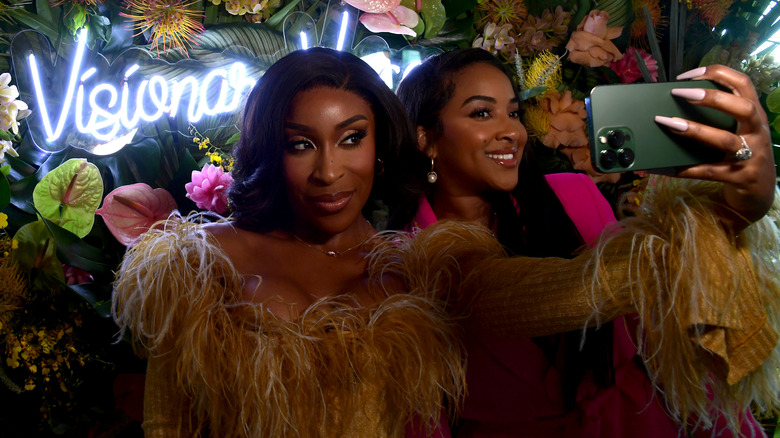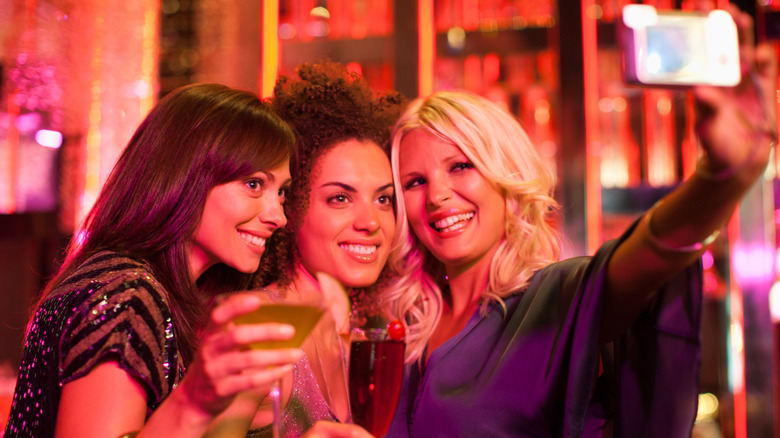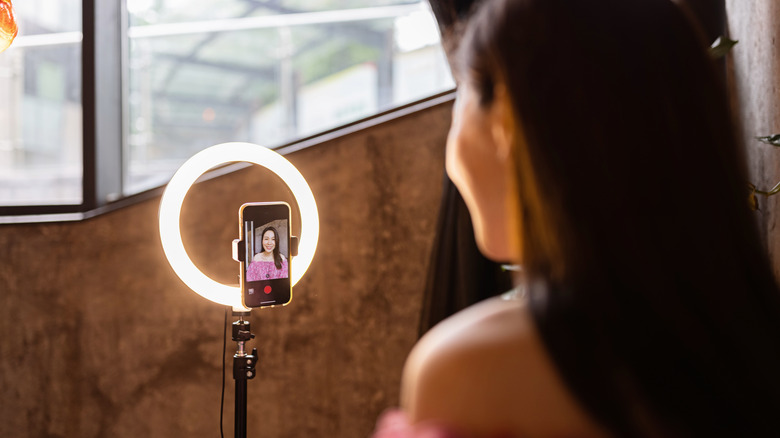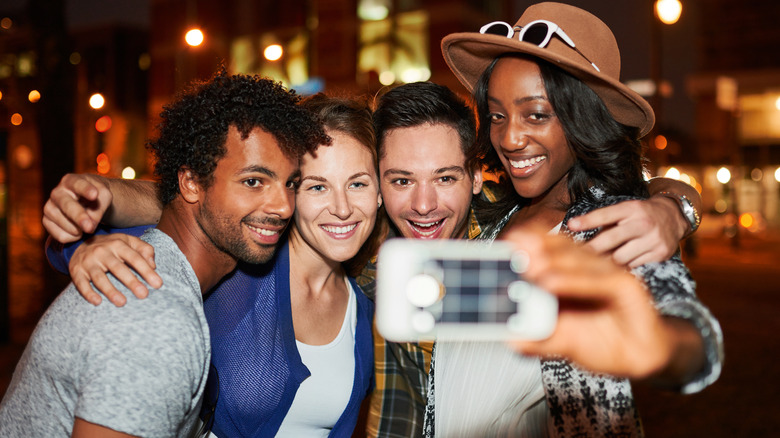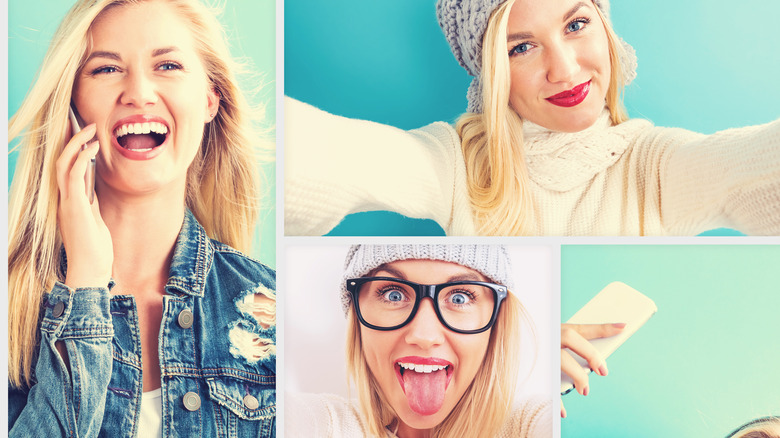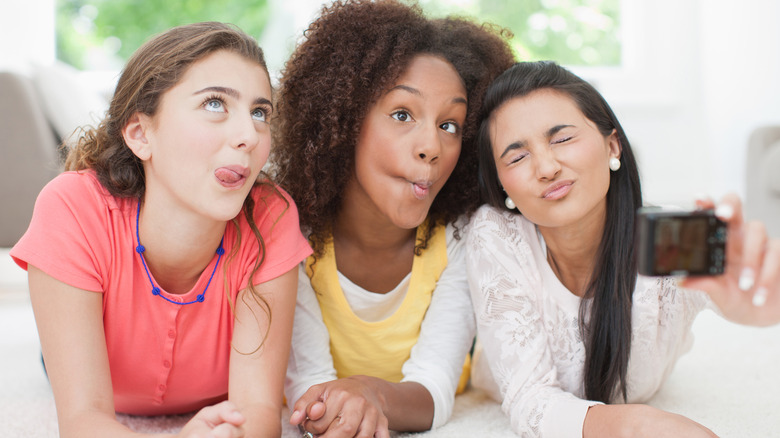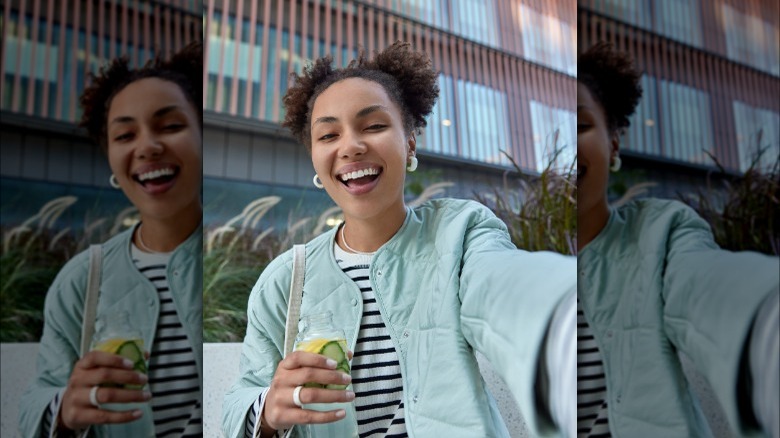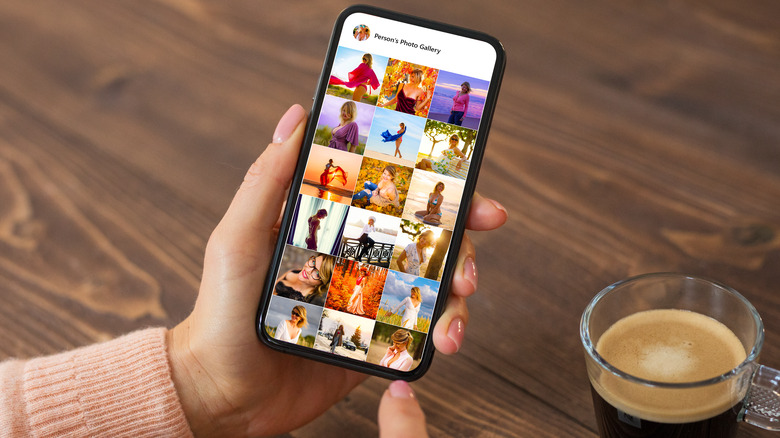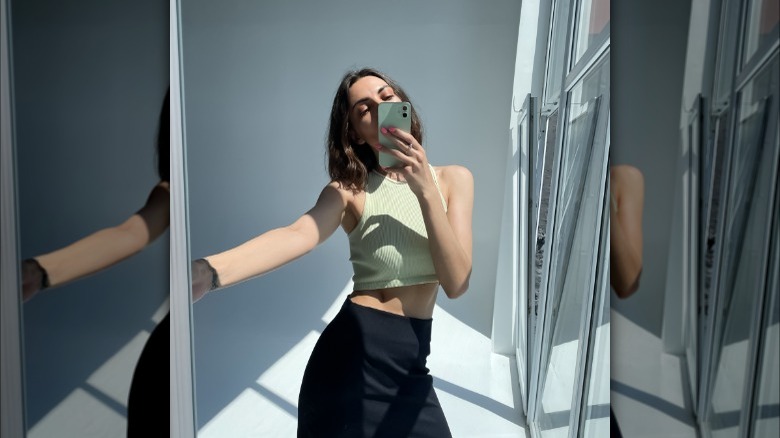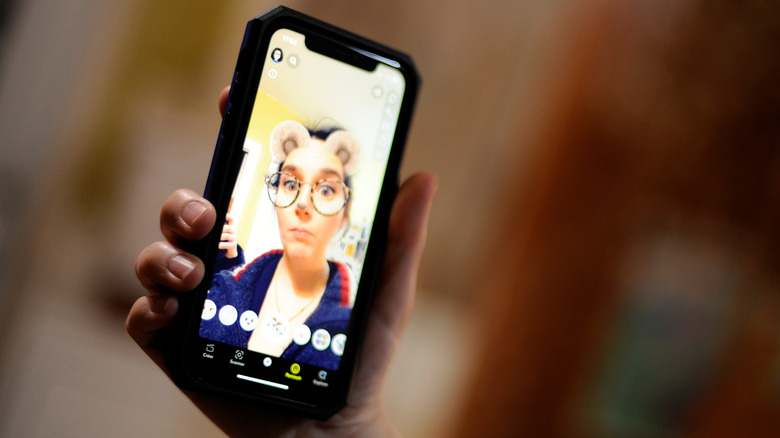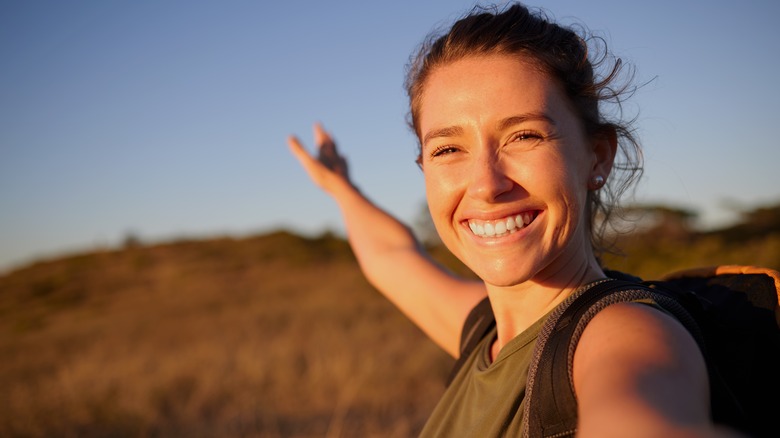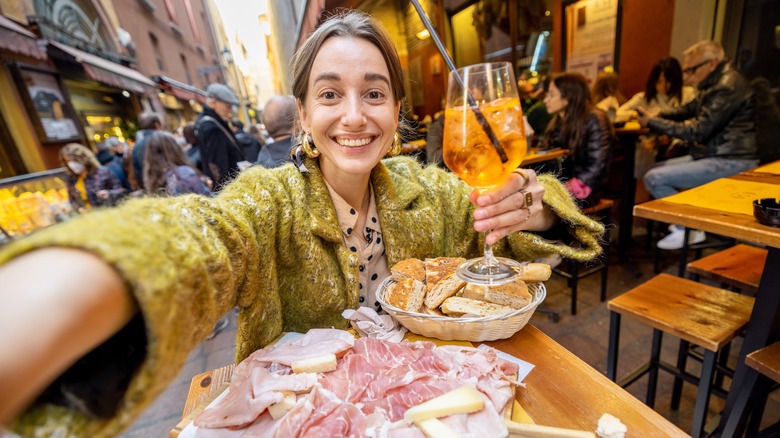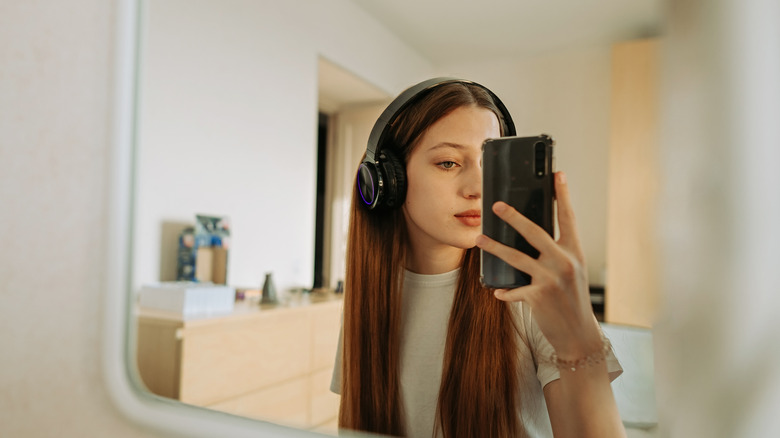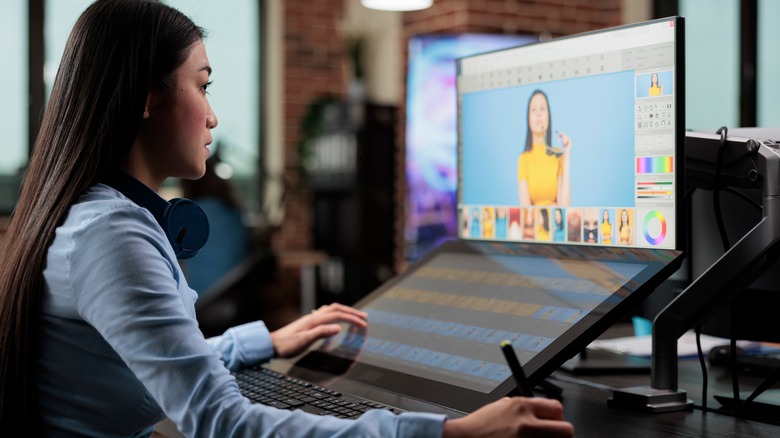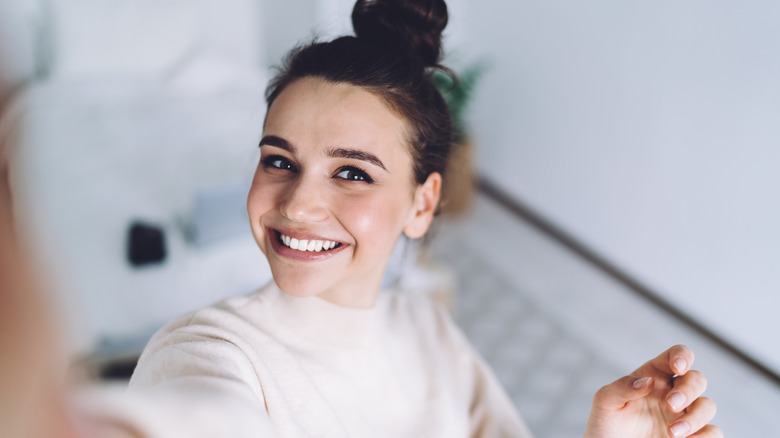Taking Selfies Is An Art, So Take These Notes For Better Portraits
Historically, selfies existed for a long time as painters across the globe explored the art of a self-portrait, but the selfie as we know it today became popularized with the rise of social media platforms like Myspace, Facebook, and Instagram. The first official camera selfie was taken in 1839 by photographer Robert Cornelius (imagine standing in your selfie pose for 10-15 minutes), but some would argue that the modern selfie was invented by Y2K icon Paris Hilton in the early aughts (via The New York Times).
While selfies are a part of our social media presence, they can also be quite intimidating, especially if you don't feel confident in your selfie-taking skills. Luckily, there are a couple of easy rules you can implement to look and feel better in photos as you strengthen your selfie game this year. Keep in mind that these are just guidelines — at the end of the day, selfies are an art form, and art doesn't really follow any rules!
Find your best angles
The most crucial secret to that good selfie is the right angle. Some angles enhance our good features, while others enhance the features we don't like. And this is true whether you're a regular person or as famous as Kim Kardashian.
If you're someone who tends to go to extremes with angles, we recommend avoiding that as it will result in very unnatural-looking photos. "Often individuals tend to go very high with their camera angles or very low, which makes it look like your forward-facing camera was turned on accidentally," Christine Buzan, the founder of Look Good in Photos, shares with Metro. "Opt for keeping the lens between nose and eyebrow height for a more neutral and natural look." Apart from the angle, the distance between your phone and your face can also affect the result. "I've heard patients and family members say, 'Oh, look at my nose, it looks so big,' when they show me a selfie," plastic surgeon Boris Paskhover, M.D., tells Live Science. "I was always telling my patients, 'That's not how you really look.' I knew that selfies distort how your nose looks."
The best way to find your good angles and the perfect distance from your face is to take a bunch of selfies, moving your face slightly in each one of them. Try not to pay too much attention to your eyes and mouth, as those two can always be adapted — instead, focus on your chin, cheeks, and nose.
Use good lighting, preferably natural
Lighting can completely change your selfie and quickly take it from drab to fab. It can help hide skin texture, enhance your eyes, and showcase that natural (or highlighted) glow. Natural light is always the best choice for selfies. In fact, golden hour selfies are some of the most magical ones you can take, as the sunlight will cast a perfect golden shade onto your skin. Depending on where you live, the time for golden hour might differ, but generally, it's one to two hours before sunset.
However, natural lighting isn't always available, so you'll often just have to work with what you have. "If you're not using a flash, be sure you're facing the light source straight on, not from the side. It should shine directly on you to clean out the face," Troy Jensen, celebrity makeup artist and photographer, tells Refinery 29.
While great lighting will enhance your natural beauty, bad lighting isn't doing you any favors. "Poor lighting draws attention to fine lines and can give the illusion that you're tired or look older than you actually are. Complimentary lighting illuminates your skin, making it appear softer and minimizing wrinkles," the founder of Look Good in Photos, Christine Buzan, shares with Metro. "Avoid taking backlit photos that are in front of a window, in direct, midday sunlight, or under fluorescent lighting. Opt instead for natural light facing a window, shade, overcast skies, or golden hour."
Don't be afraid to use the flash
Back in the days when millennials were still taking selfies with cameras (not phones), using the flash would often result in red eyes, which undoubtedly ruined a great photo. However, Gen Z is known for overcoming the fear of flash selfies, and for a good reason. Facetune notes that flash is absolutely necessary for any photos taken during the night or in dark spaces.
If you struggle with taking good flash selfies, ask a friend for some help. Have them use their phone and turn the flash on, giving you constant lighting so that your eyes don't squint in the photo. And if you tend to get embarrassed if you're taking a flash selfie in a crowded room as the light might make you the center of attention — you'll just have to get over it. After all, we all take selfies, and if someone is judging you, it's probably because they wouldn't dare to do what you're doing.
Take plenty of pictures — no one gets the best selfie right away
If you're in a public setting, you might feel awkward taking a bunch of selfies, which is totally understandable. However, if no one is around you, the best thing you can do to ensure you get that perfect shot is to take a lot of photos. And we mean it. Whether that be 50, 100, or more, give yourself plenty of options to choose from.
Even selfie queen Kylie Jenner admitted to DailyMail that she snaps away when taking her famous photos. "I take, like, 500 selfies to get one I like. Sometimes I regret putting one up if I find a better one later. I'm like damn, that's a better photo, but that's the only thing I regret." Once you're done taking the selfies, go through them, favorite all the ones that have potential, and delete everything else. By the end of this process, you should be left with some strong contenders, and all that's left to decide is which one (or few) you will share on your social media.
Use your phone's back camera
Even though front cameras were initially invented to help with long-distance business meetings (via Quartz), today, it seems as if they were created for selfies, as they are often even called selfie cameras. However, even though the fact that you can see yourself on the screen while taking photos tends to make the selfie process easier, selfies taken with a back camera are just overall better.
First off, the back camera on most phones has a much higher quality, meaning that your selfies will come out a lot crisper. Second, you can use flash, which we already went into detail about. And third, you will look straight into the camera instead of looking at yourself while taking a selfie — a subtle change that will elevate your selfie game. Sure, most of the selfies might not turn out right, but that's why you'll take a lot of them!
Use a self-timer or a self-timer app
Sometimes it's hard to press the camera button and look good simultaneously — especially if you're using your back camera. Because of this, we recommend using a timer to give you a couple of seconds to adjust your angle and pose. While you can use the built-in timer on your phone, there is also a plethora of selfie-taking apps that will make this process easier for you.
One of them is Lens Buddy, which rose to popularity in recent years thanks to its ability to take a bunch of photos without you having to do anything but pose. "Taking a selfie is something we've all done a thousand times, yet this app makes it so much better. Batch photos mean there's more room to be natural in the photos. What impressed me was the 'prepare for photoshoot' mode. It's customizable, with my favorite being the app reading off to you when you're centered in the shot. Such a small but important detail that makes this app an essential," a satisfied user raves about it on the App Store.
Look for inspiration online
Hey, there's no shame in copying a pose or style of photo from someone else — especially if you struggle with taking photos of yourself to begin with. After all, no two selfies will ever turn out exactly the same, but if that beauty blogger you've been following for years always posts fire selfies, consider learning a thing or two from them.
Photographypla.net notes that some of the best sites to use for inspiration are Instagram and Pinterest, but you can also use less mainstream websites such as Particulr and 1X. When you're trying to recreate an image you found online, take notes of the lighting, the angle, and the model's pose. You can also draw inspiration from different pictures and combine what you like into your selfie. And even though you don't have to, you can always tag or give a shoutout to the person whose image inspired your photo!
Avoid having shadows on your face (unless you're going for that)
Regardless of whether you're using natural or artificial light, be mindful of the fact that shadows can easily form. This is particularly true if you're directly turned towards the light source — chances are a shadow of your hand holding your phone will be visible on your face. This is obviously something you want to avoid.
Apart from making sure a shadow of your hand isn't visible, harsh overhead lighting is not your friend. "There is nothing worse than having a huge shadow cast over your face," photographer and style blogger Candice Lake tells Allure. "When in doubt, face directly into or away from the sun. If it's the middle of the day and the sun is high, the shadows can look like bags under your eyes. The golden hour to shoot a photo is during sunrise or sunset, when the light is low and the most beautiful."
However, if you're trying to incorporate cool shadows into the photo — go for it! Shadows can easily make a photo much more interesting if they are intentional.
Avoid using filters when taking selfies
When filters first came out, they were very obvious and most commonly only used for fun. After all, who could forget Snapchat's dog filter era? However, since then, filters have become much more realistic, and most recently, the internet went wild over TikTok's "Bold Glamour" filter, which makes you look like you have a full face of makeup on but is almost undetectable (via BGR). However, filters aren't real life, and while you can tweak things with makeup and lighting, a filter generally changes your face completely.
"We've always had the challenge of images being filtered and doctored to make unrealistic measures for what beauty looks like," Dr. Helen Egger reveals to Forbes, noting that, back in the day, we would compare ourselves to photoshopped magazine images. "What is taking it to the next level with these filters is it's not just seeing an image of a celebrity who is unrealistic and measuring yourself against that person; it's measuring your real self against a pretend image of yourself," she adds. "These face filters are using algorithms to reinforce a certain standard of beauty that is very narrow," and "doesn't support individuality; it supports conformity with what's the standard of beauty."
If your phone has portrait mode — use it!
A lot of phones now come with portrait mode, but numerous apps provide the same effect. However, not many use this option, perhaps because they are unsure whether they're doing it right or don't think it looks better. Per Apple, portrait mode provides a depth-of-field effect, and it quickly takes your photos from amateur to kind of professional. Snappy Snap notes that portrait mode is great for putting you into focus, as everything behind you will be slightly blurred out.
However, it is advised that you ensure your subject (which in this case would be you) is at least 19 inches away from your camera (via Business Insider). Since this isn't always easily achieved with your arm, a selfie timer and a place to position your phone are what we would recommend. And, of course, a portrait mode selfie doesn't always work — sometimes you want to take a selfie and have your background visible, and in that case, we recommend sticking to normal settings.
Be mindful of your background
According to Recordnet, a background often makes or breaks a good photo. If you ask us, this also applies to selfies. Because you also need to focus on finding good lighting and the right angle, it's not surprising that the background often gets neglected.
Depending on the background you're working with, you can also decide if you want to use portrait mode. If the background isn't worth seeing, make sure it's blurred out. Apart from that, we recommend that you always try to find a background that won't take the attention away from you. In fact, the more simple it is, the better.
But don't fret if you end up getting something in your background that you wish wasn't there. If you're lucky, you'll be able to crop it out, and if not — try making fun of it in the caption. After all, if nothing can be done about it, you might as well use it to your advantage!
Practice what you'll do with your face in the selfie
A lot of people don't know what to do with their faces while taking a selfie, which is why they tend to come out unnatural and forced. "Both sides of your face are not identical," photographer and social media star Asiyami Gold suggests (via Elle). "Study your face in the front-facing camera and figure out which side you like best."
The founder of Photography experts ParrotPrint.com, Matt Dahan, also shared some tips with Manchester Evening News: "The camera picks up everything, so if you're feeling pretty tense, it's likely to be exposed through stiff shoulders and posture. Try to relax and let your shoulders drop for a much more natural-looking photo," he says. "Although it sounds silly, try not to gravitate towards any typical poses in your photos. Try asking someone to make you laugh, or ask them to snap away while you're doing something to get some natural, candid shots."
Practice makes perfect, which is why you should play around with your face while posing in the mirror. After that, make different facial expressions while taking a lot of selfies. This is the only way you can end up knowing what your go-to facial expressions and poses should be.
Don't go crazy with the editing
According to NBC News, about two-thirds of us usually edit our selfies — which means that you can't really trust what you see on Instagram. "When you are improving or finessing your own images, you know that you're starting out with an authentic image and just enhancing it," Julie Cottineau, founder and CEO of BrandTwist, tells NBC News. "But when you're looking at someone else's image, you question it because you don't know how real it was, to begin with. Anything could have been done to it."
Of course, making sure everyone posts unedited photos of themselves online is impossible, but any change starts small, which is why we encourage you (as well as ourselves) only to edit the photos if necessary and stick to things like contrast, saturation, and brightness instead of manipulating photos to look completely different. It may not be easy, but if the people around you see the real you online, it might just help their mental health. "These images are around us day and night now and can cause us to compare ourselves to other people," psychologist Dr. Nia Williams tells BBC. "If we see ourselves not looking as perfect as an image online, then it can have a negative impact on young people's self-confidence and self-image."
Don't take selfies too seriously
Even though we just listed a bunch of things you can do to improve your selfie game, we also want to stress that at the end of the day, selfies should be fun and not something you spend hours on. Whether you want to capture yourself in front of a beautiful building or you're just feeling yourself — a selfie is there to help you capture a moment. And not to mention that if you spend a lot of time getting that perfect selfie, chances are it will be super noticeable.
Apart from that, keep in mind that social media should be used to make others (and yourself) feel better and not worse. "People are struggling with their self-image and self-confidence more than ever," musician Lizzo tells Forbes. "This is amplified by the increasing pressure to show a digitally distorted version of ourselves, reinforcing the idea that our beauty in real life is not good enough or worthy of likes." So next time you think a selfie is not good enough to post, think again. And don't be afraid to take a social media break between selfies.
